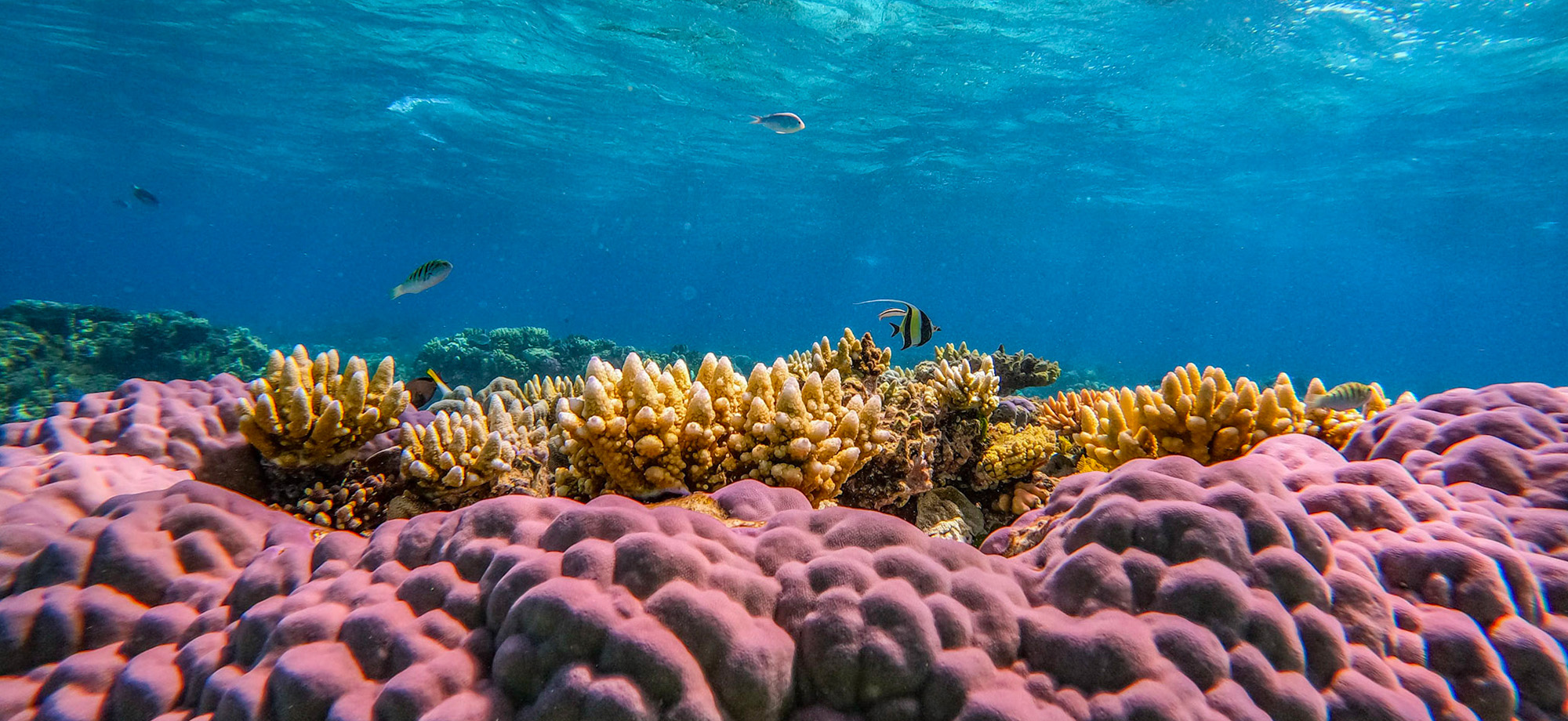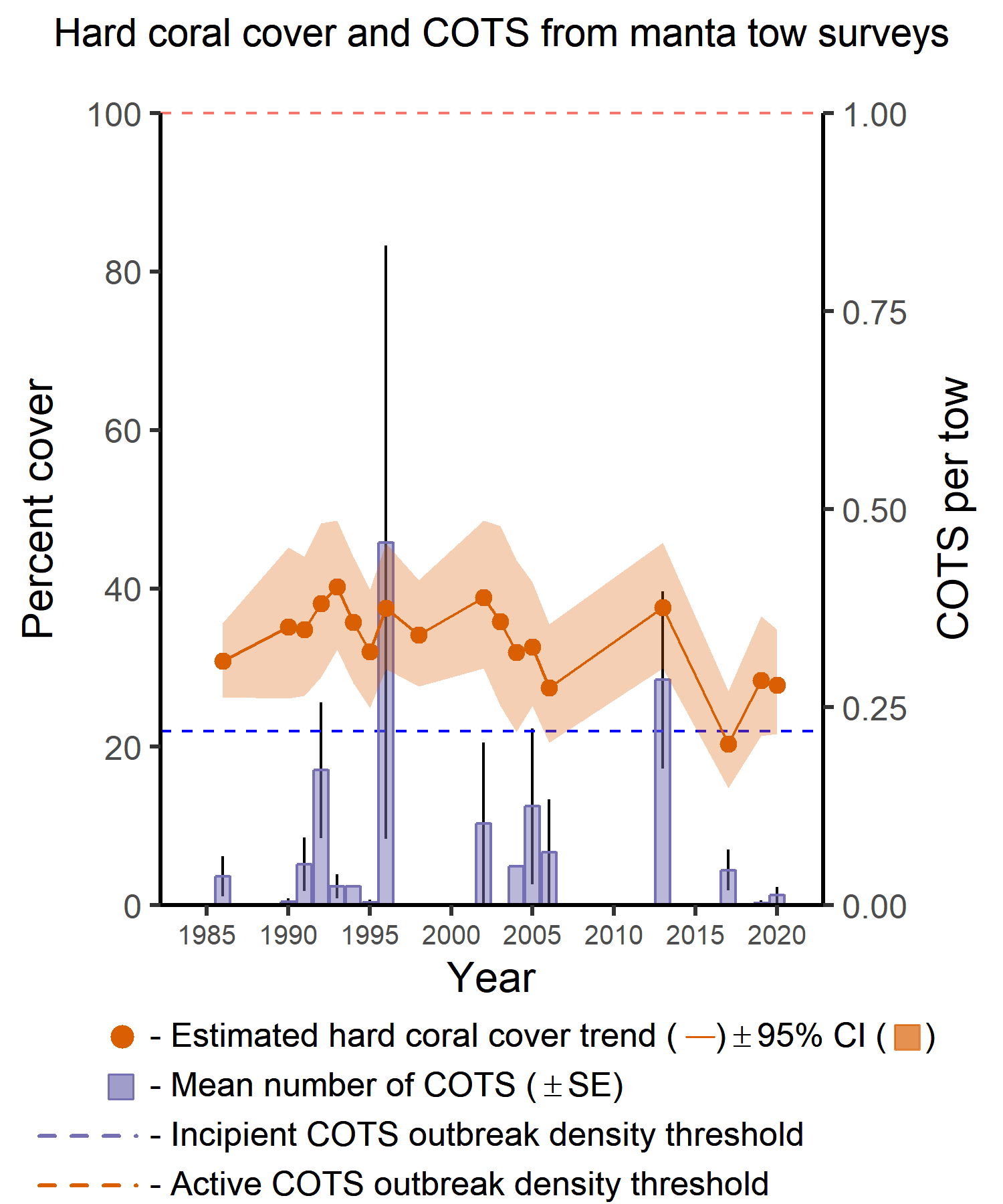Summary
- Fourteen reefs were surveyed in this sector
- Sector-wide hard coral cover was moderate.
- Eight reefs were previously surveyed in January 2019; hard coral cover had increased on seven reefs and was unchanged on one.
- Three previously unsurveyed reefs had low coral cover.
- Low levels of crown-of-thorns starfish were recorded at three reefs.
- Coral bleaching was widespread, but at low levels (scattered, individual colonies).
Hard Coral Cover 0-10% 10-30% 30-50% 50-75% 75-100%
Figure 1: Map showing location of reefs in the Cape Grenville sector.
Table 1: Overview of results obtained from manta tow surveys of reefs in the Cape Grenville sector
| Cape Grenville Sector | Summary | Trend since last survey. |
|---|---|---|
| Average Coral Cover (%) | 27.76 | Stable |
| COTS status: | No Outbreaks | Stable |
| Coral bleaching: | Low | Decreased |
As part of the Long Term Monitoring Program (LTMP), manta tow surveys of hard coral cover and the abundance of the coral feeding crown-of-thorns starfish (COTS), Acanthaster cf. solaris* were completed on fourteen reefs in the Cape Grenville sector of the Great Barrier Reef (GBR) (Fig 1). Preliminary results of the manta tow surveys are presented in Tables 1 and 2[ME1] . The overall median hard coral cover for the sector was moderate (10-30 %) (Table 1) (Fig 2) which was unchanged since the previous surveys in January 2019.
Eight reefs were previously surveyed in January 2019 and hard coral cover had increased on seven reefs and was unchanged on one reef. Pearson Reef, Second Small Reef and Reef 12-071 had previously been surveyed between three and 24 years ago. Coral cover remained unchanged on Pearson Reef (0 to10%) and Reef 12-071 (30 to 50%) but had declined to moderate (10 to 30%) levels on Second Small Reef. An additional three mid-shelf reefs (McSweeney Reef, Monsoon Reef and Reef 11-162) were surveyed for the first time in December 2019 and all had low coral cover (0 to 10%), likely reflecting the impacts of the recent bleaching events. Severe Tropical Cyclone Trevor (category 4) crossed the coast to the south near Lockhart River in February 2019 but had little or no impact on reefs in this sector.
Scuba surveys of fixed transects recorded low levels of coral bleaching on all reefs, restricted to scattered individual colonies. Cases of coral disease were low on all reefs, as were numbers of the corallivorous snail, Drupella spp. Very low numbers of COTS were recorded on during fixed site surveys on three reefs Monsoon, McSweeney, and 11049S.
Details of the manta tow method can be found in the Standard Operational Procedure No. 9 [AIMS Research - Crown-of-thorns Starfish and Coral Surveys - Standard Operational Procedure 9]. Further details of the monitoring program design, sampling methods and a full explanation of the A. solaris outbreak terminology can be found on the AIMS website.
*Note: genetic studies show that there are at least four species of COTS. These are the North and South Indian Ocean species (A. planci and A. mauritiensis), a Red Sea species (not yet named) and a Pacific species. The range of the Pacific includes the Great Barrier Reef and it has been provisionally named Acanthaster solaris (Haszprunar et. al. 2017).
Table 2: Summary of manta tow surveys of reefs in the Cape Grenville sector. Arrows indicate the trend in live coral cover and A. solaris since last survey; ▲ = increase, ▼ = decrease, " " = no change. A. solaris Outbreak Status: NO no outbreak, IO incipient outbreak >.22 COTS per tow, RE recovering, AO = Active Outbreak>1 COTS per tow.
| Reef | Shelf Position | Tows | Previous survey year | A. solaris | A. solaris per tow | A. Solaris Outbreak Status | Live Hard Coral Cover % | Soft Coral Cover % | Survey Year |
|---|---|---|---|---|---|---|---|---|---|
| ASHMORE BANKS (2) | Mid | 16 | 2019 | 0 | 0 | NO | 54.37 ▲ | 4.21 ▼ | 2020 |
| ASHMORE BANKS (3) | Mid | 10 | 2019 | 0 | 0 | NO | 50.11 ▲ | 2.49 ▼ | 2020 |
| MIDDLE BANKS (2) | Mid | 10 | 2019 | 0 | 0 | NO | 49.15 ▲ | 4.97 ▲ | 2020 |
| MIDDLE BANKS B (3) | Mid | 10 | 2019 | 0 | 0 | NO | 61.39 ▲ | 7.45 ▲ | 2020 |
| PEARSON REEF | Mid | 37 | 2017 | 0 | 0 | RE | 10.06 ▼ | 2.43 ▼ | 2020 |
| LAGOON REEF | Outer | 55 | 2019 | 0 | 0 | NO | 39.23 ▼ | 4.36 ▼ | 2020 |
| SECOND SMALL REEF | Outer | 26 | 2006 | 0 | 0 | NO | 20.95 ▼ | 4.32 ▼ | 2020 |
| ASHMORE BANKS (1) | Mid | 12 | 2019 | 0 | 0 | NO | 43.22 ▲ | 2.49 ▼ | 2020 |
| 11049S | Mid | 33 | 2019 | 0 | 0 | NO | 3.11 ▼ | 2.5 ▼ | 2020 |
| 11162S | Mid | 29 | NA | 0 | 0 | NO | 8.88 | 2.59 | 2020 |
| MCSWEENEY REEF | Mid | 29 | NA | 4 | 0.14 | NO | 2.84 | 2.41 | 2020 |
| MONSOON REEF | Mid | 24 | NA | 1 | 0.04 | NO | 7.19 | 2.5 | 2020 |
| 12071S | Outer | 27 | 1996 | 0 | 0 | NO | 39.11 ▲ | 4.07 ▲ | 2020 |
| MANTIS REEF | Outer | 36 | 2019 | 0 | 0 | NO | 21.67 ▲ | 7.36 ▲ | 2020 |
Figure 2: - Sector-wide changes in coral cover and the numbers of A. solaris for survey reefs in the Cape Grenville sector of the GBR. Orange trend line = Hard coral. Purple bars = Crown-of-thorns (COTS)
Image 1. Stands of dead coral on Mc Sweeney Reef, likely caused by the 2016 bleaching event
Image 2. There was an increase in hard coral cover recorded at Lagoon Reef, with extensive stands of healthy coral in some parts of the reef.
Image 3. While coral cover is increasing on Lagoon Reef, there was still damage evident from the passage of Tropical Cyclone Penny in early 2019.





